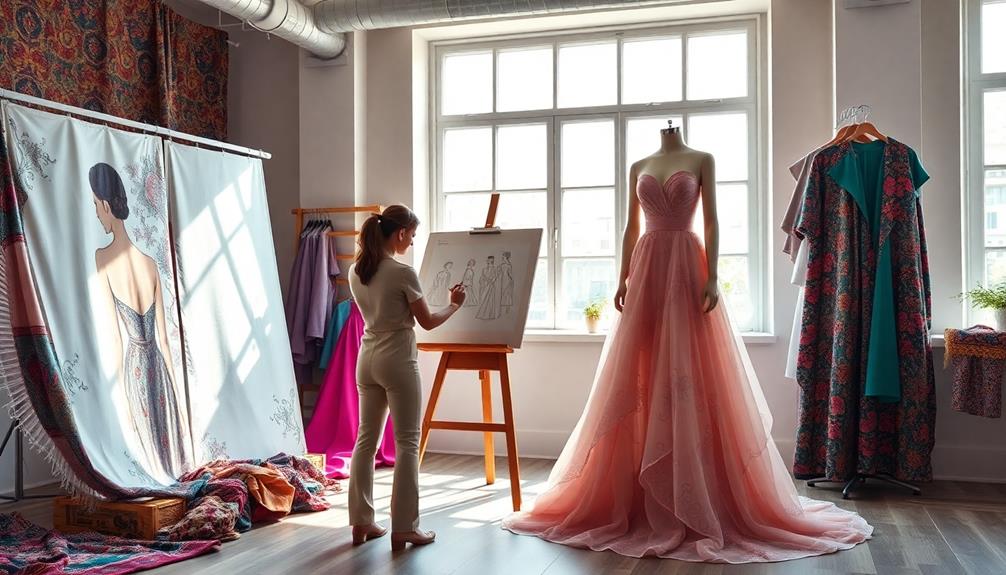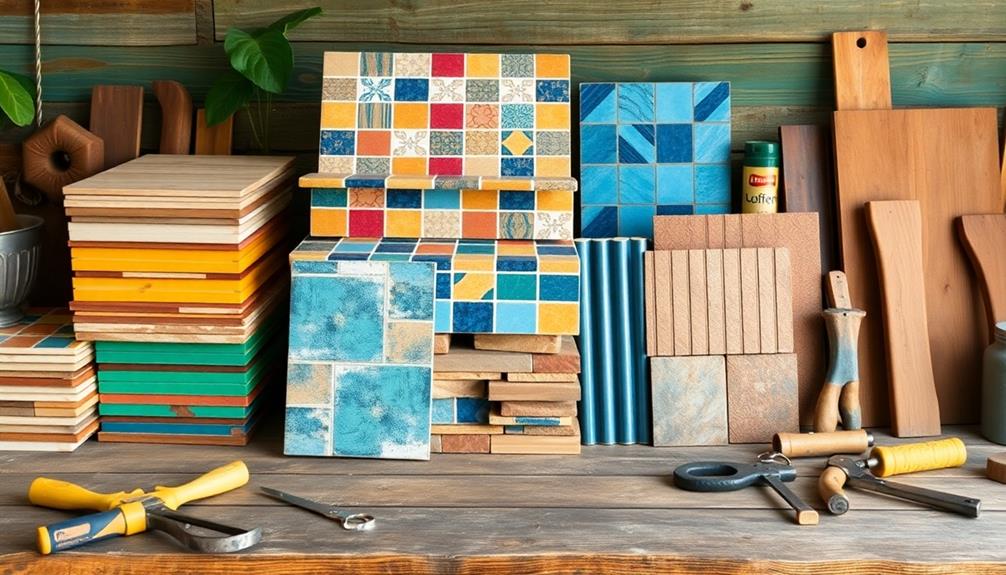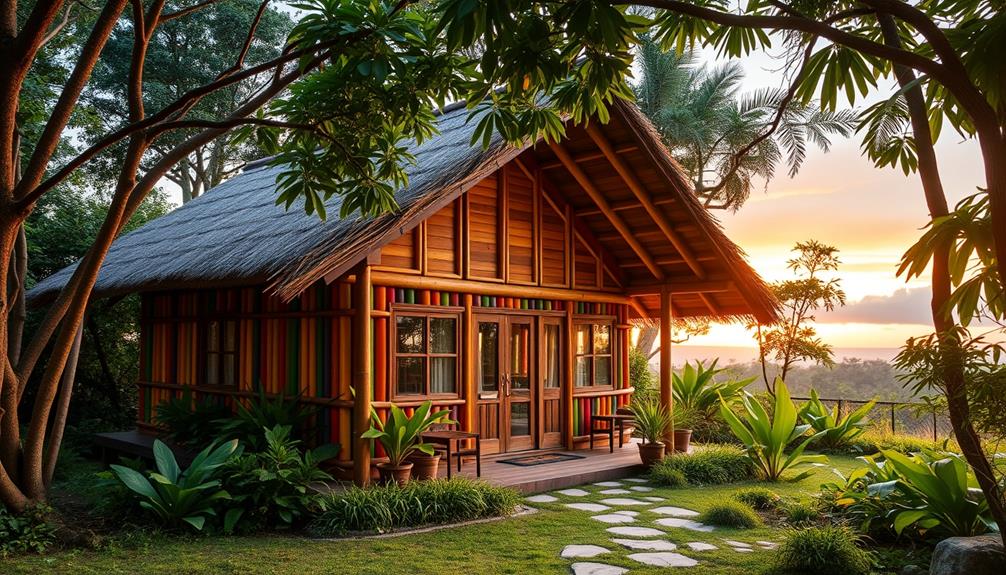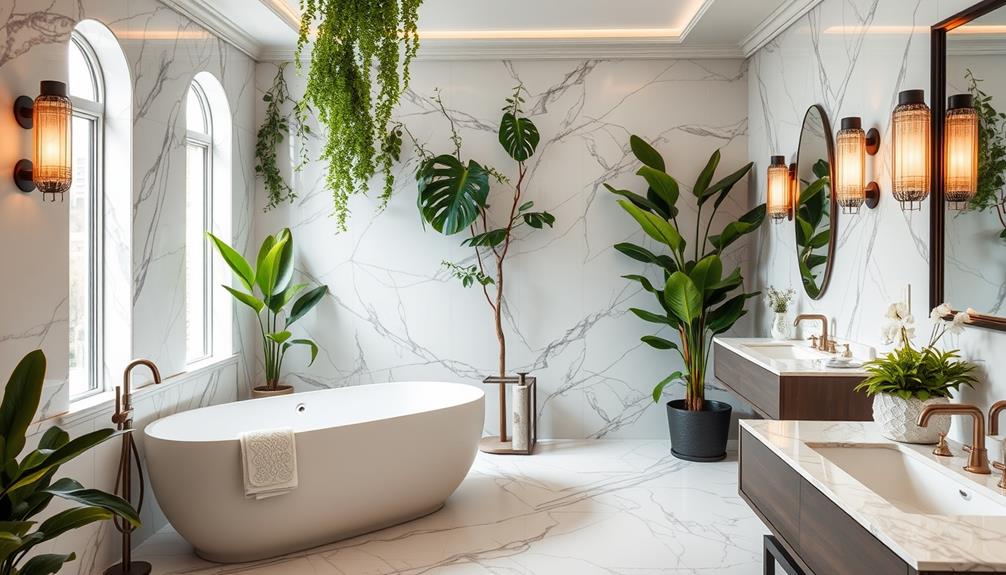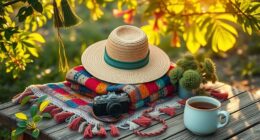To excel in the craft of dress design, it is important to seek inspiration from a variety of sources such as nature and the history of fashion. Carefully select fabrics; materials like chiffon and silk are ideal for creating sophisticated looks, while cotton is great for more casual styles. Precision in cutting and sewing techniques is crucial, so investing in the right tools and ensuring accurate measurements is key. Remember to go through the fitting process—building a prototype with muslin can help you achieve the perfect silhouette. Pay attention to flexibility, comfort, and durability in your designs. Keep learning and you will discover even more tips to enhance your skills.
Key Takeaways
- Draw inspiration from diverse sources such as nature, art, and fashion history to spark creativity in your designs.
- Select fabrics based on the desired look and feel, considering options like chiffon for maxi dresses and silk for evening wear.
- Utilize precise cutting and sewing techniques, ensuring accurate measurements and appropriate stitching for different fabric types.
- Create fitting prototypes to test comfort and silhouette, making adjustments based on the wearer's feedback for the best fit.
- Incorporate unique design elements and embellishments while ensuring durability and functionality, particularly for specialized costumes.
Design Inspiration and Color Selection
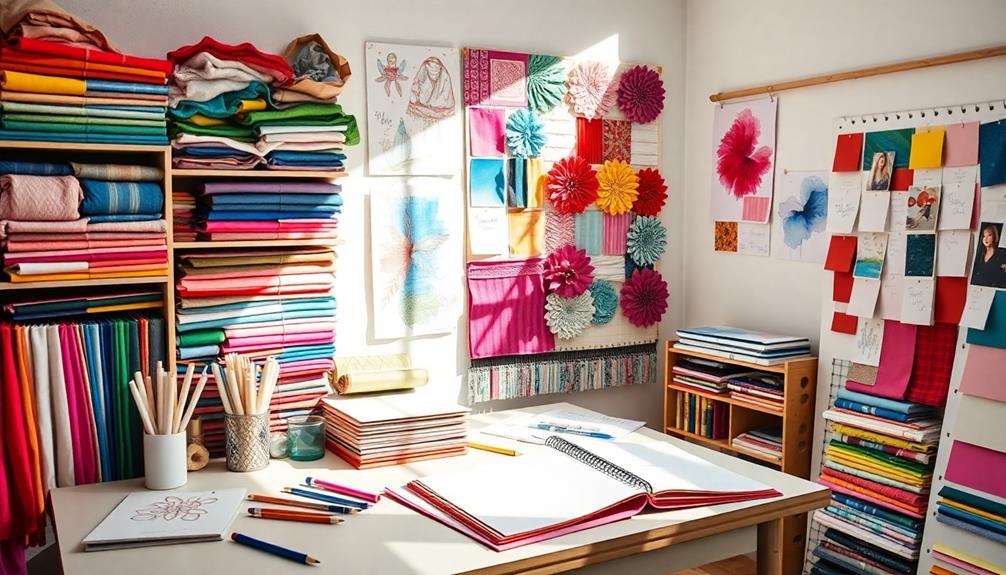
When diving into dress design, finding the right inspiration can spark your creativity and set the tone for your entire project. When diving into dress design, finding the right inspiration can spark your creativity and set the tone for your entire project. Sometimes, ideas can stem from unexpected moments, like scenic landscapes or events filled with energy and emotion. For instance, choir retreat creativity ideas may provide unique color palettes, flowing silhouettes, or melodic themes that can influence the design process in unexpected and harmonious ways.
Begin by exploring various sources like nature, art, or fashion history to ignite your imagination. Consider the occasion for which you're designing; a formal event might call for classic silhouettes and rich hues, while a summer gathering allows for playful patterns and vibrant colors.
Pay attention to your color scheme, ensuring it complements the theme and the wearer's complexion. Don't shy away from unique embellishments like lace or sequins to add flair.
Ultimately, focus on creating a cohesive design that reflects your vision and resonates with the intended audience, making the dress a true standout piece.
Fabric and Material Choices
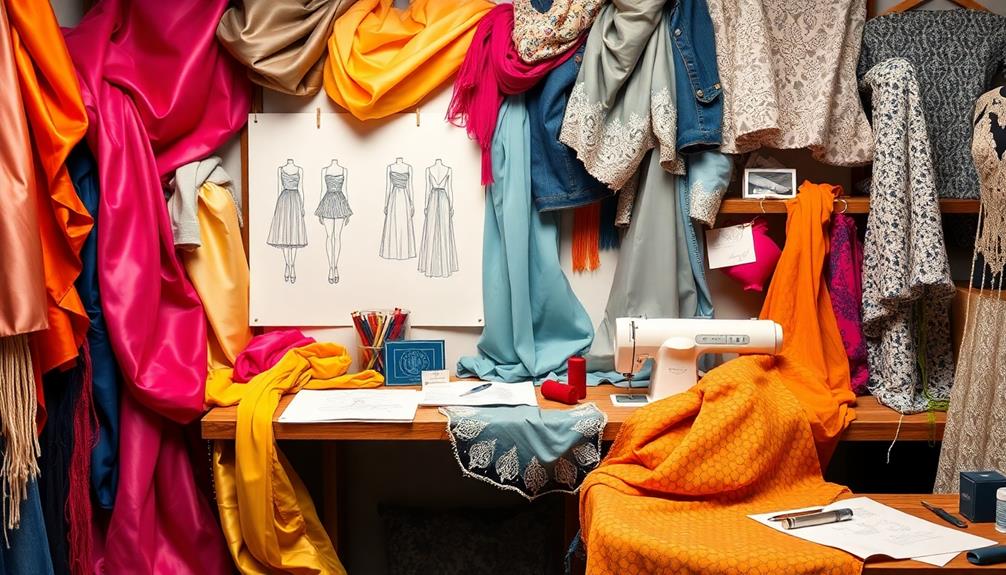
Finding the perfect fabric is just as important as choosing the right design inspiration and color scheme. Your fabric choice will greatly impact the dress's overall look and feel. Consider the style you're aiming for—fluid fabrics like chiffon and silk work wonders for maxi dresses, while cotton and wool suit structured styles.
Here's a quick reference table to help you decide:
| Fabric Type | Best Use |
|---|---|
| Chiffon | Maxi dresses |
| Silk | Elegant evening wear |
| Cotton | Casual wear |
| Wool | Structured styles |
Explore sustainable options too, like organic cotton or linen. Always assess the fabric's drape, texture, and weight to make sure it enhances your design.
Cutting and Sewing Techniques
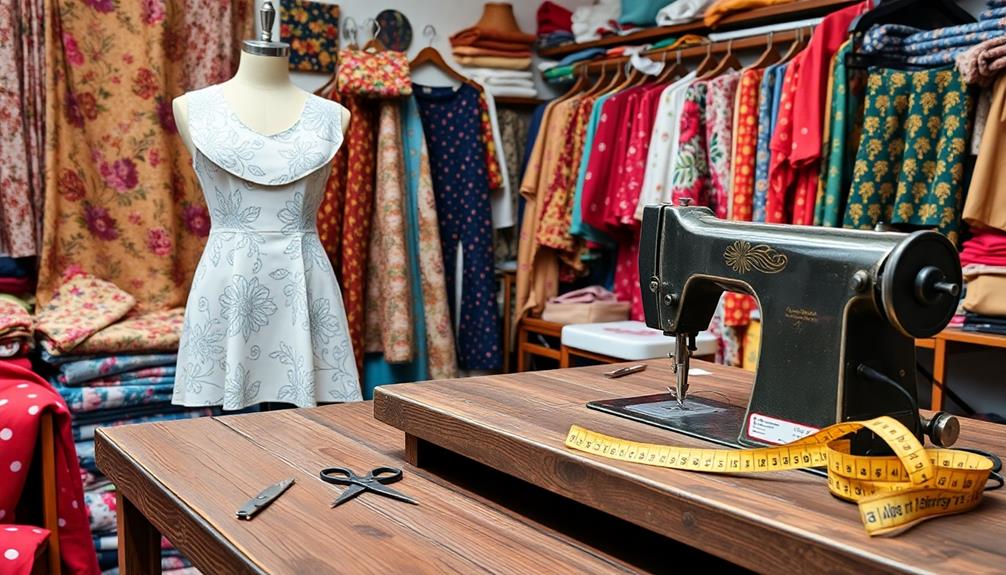
Mastering cutting and sewing techniques is essential for achieving a professional finish in dress design. Start by gathering your tools: sharp scissors, rotary cutters, pins, and a reliable sewing machine.
Accurate measurements with rulers and tape measures will guarantee precision in your cuts. When cutting fabric, always use a flat surface to prevent shifting, and be mindful of the grainline for ideal drape.
Choose appropriate stitching techniques like straight, zigzag, or backstitch for different fabric types. Keep your seams neat by serging the edges to prevent fraying.
Throughout the process, regularly check the fit on a dress form or the intended wearer, making adjustments as needed. This attention to detail sets the foundation for your stunning designs to shine.
Fitting and Alteration Process
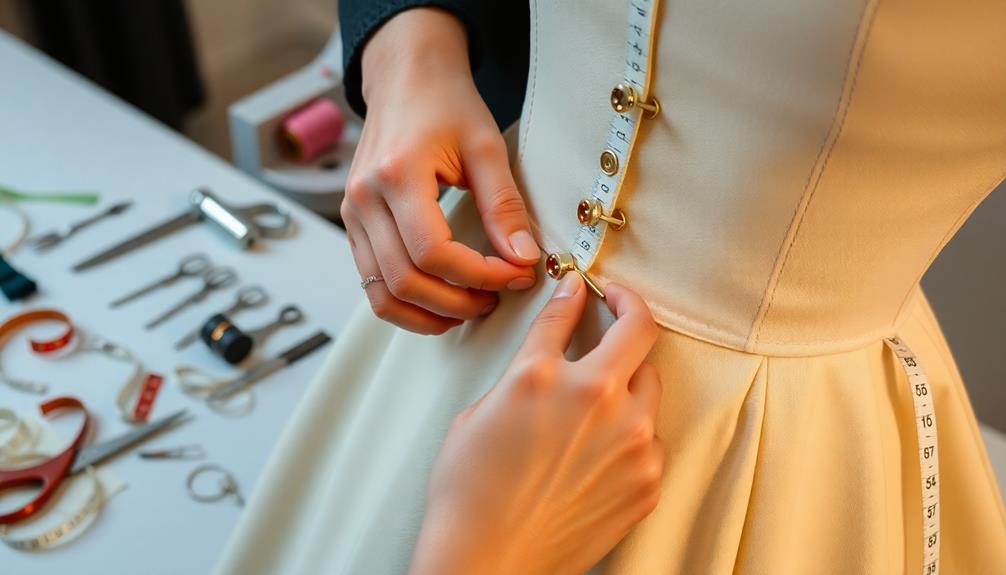
In the fitting and alteration process, accurate measurements are essential for achieving the perfect fit. Start by taking initial measurements, then create a fitting prototype using muslin or similar fabric.
Schedule fitting sessions with the wearer to assess comfort and ease of movement. As you adjust, focus on areas like hems, waistlines, and seams, ensuring each alteration enhances the overall silhouette.
Don't hesitate to make multiple adjustments, as achieving that tailored look often requires several iterations. Always prioritize the wearer's feedback; it's invaluable for fine-tuning the design.
Specialized Design Considerations

Understanding specialized design considerations is vital when creating garments for specific purposes, such as dance costumes or theatrical attire.
You'll want to prioritize flexibility and movement by selecting fabrics like spandex or chiffon, which allow for ease of motion. Durability is essential, so make certain that your materials can withstand the rigors of performance.
Reflect the performance's theme through color and design elements, integrating functional features like breathability and stretch.
Don't forget to take into account the unique requirements of each specialized costume, such as quick changes or specific character details.
Frequently Asked Questions
How Do I Choose the Right Dress Style for My Body Type?
To choose the right dress style for your body type, identify your shape, embrace your best features, and experiment with silhouettes that enhance your figure. Don't forget to take into account comfort and personal style for confidence!
What Are the Best Online Resources for Dress Design Inspiration?
Finding online dress design inspiration is like discovering a treasure chest! Check out Pinterest, Instagram, or dedicated fashion blogs. They're filled with stunning visuals and ideas that'll spark your creativity and ignite your passion for design!
How Can I Incorporate Sustainable Practices Into My Dress Design?
You can incorporate sustainable practices by choosing eco-friendly fabrics, sourcing materials locally, and minimizing waste. Consider upcycling old garments and using non-toxic dyes to create beautiful, environmentally-conscious designs that reflect your commitment to sustainability.
What Are the Common Mistakes to Avoid in Dress Design?
Designing a dress is like steering through a maze; avoid common mistakes like ignoring fit, neglecting fabric choice, and overlooking details. Trust your instincts, seek feedback, and embrace creativity to guarantee a stunning final piece.
How Do I Market and Promote My Dress Designs Effectively?
To market your dress designs effectively, showcase your creations on social media, engage with followers, collaborate with influencers, attend fashion events, and create visually appealing content that highlights your unique style and craftsmanship.
Conclusion
As you wrap up your journey in dress design, remember, every stitch you make is a step towards your unique masterpiece. Embrace the challenges and triumphs, knowing they're just opportunities in disguise. When you blend creativity with technique, you're not just crafting garments; you're weaving stories that resonate with the heart. So, keep experimenting, learning, and refining your skills. After all, every designer's path is sprinkled with delightful surprises waiting to be uncovered.
